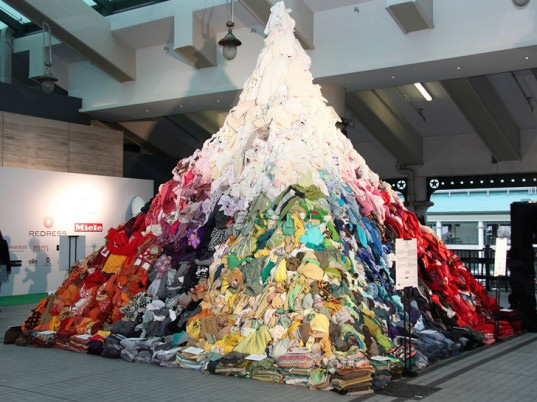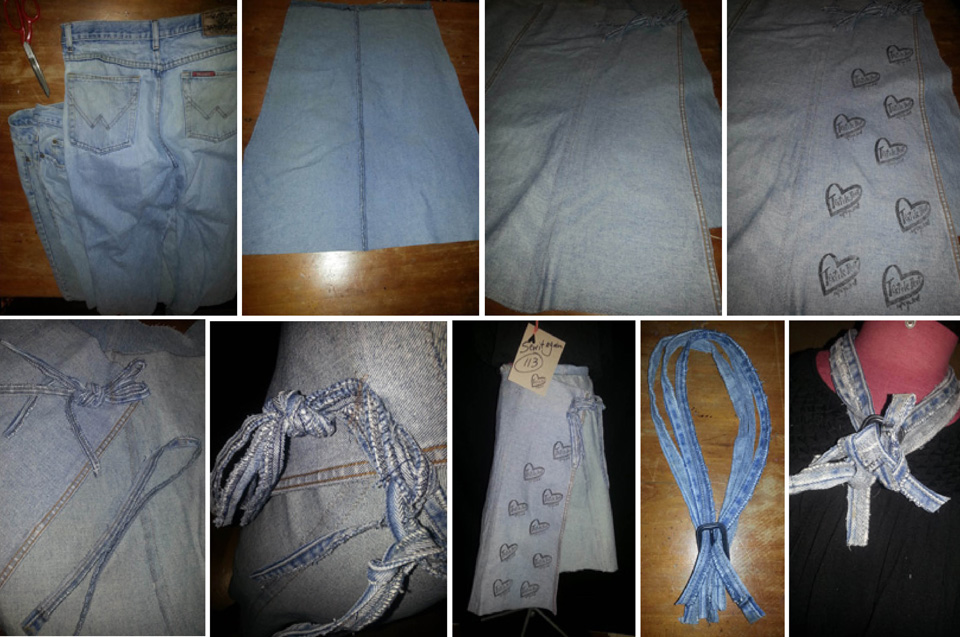 Jeans are produced in their millions annually and an average pair weighs at least half a kilogram. That’s a huge resource in terms of cotton farmed, fibre spun, fabric woven, dyed, sewn, finished and marketed.
Jeans are produced in their millions annually and an average pair weighs at least half a kilogram. That’s a huge resource in terms of cotton farmed, fibre spun, fabric woven, dyed, sewn, finished and marketed.
It is enthralling – and appalling – to think that 253 tons of clothing is thrown away by Hong Kong residents on the average day, according to their Environmental Protection Department.
Redress is a Hong-Kong based NGO with a mission to promote environmental sustainability in the fashion industry by reducing textile waste, pollution, water and energy consumption.
The 5-metre high mountain of second-hand clothing, photographed below, was designed as part of the Get Redressed campaign to illustrate the Chinese territory’s textile waste and is just the tip of a precipice because it represents only 7.5 tons of textiles, or 3% of the daily dumping of clothing.
 This Ecouterre article quotes clothing sales soared by 60 percent in the past decade. Of the 92,000 tons of textiles abandoned in landfills in 2009, 71 percent originated from domestic sources. The former British colony recovers roughly 15 percent of the waste, compared with 33 percent in the United Kingdom the same year. I’ve not yet been about to source any figures for Australian textile waste.
This Ecouterre article quotes clothing sales soared by 60 percent in the past decade. Of the 92,000 tons of textiles abandoned in landfills in 2009, 71 percent originated from domestic sources. The former British colony recovers roughly 15 percent of the waste, compared with 33 percent in the United Kingdom the same year. I’ve not yet been about to source any figures for Australian textile waste.
We live in a society of busy individuals, too busy to think much about clothing reuse. But that has got to change because such waste in unconscionable.
Fashion Revolution Day is a global movement harnessing the fashion industry as a force for good, raising awareness of its social and environmental impact to bring about ethical and sustainable change.
This year’s campaign is Who Made Your Clothes. I’m proud to be making my own clothes this year, resewing waste and reject clothing for a second life with the Sew it Again project.
Sew 113 was made from the legs of two pair of jeans cast-off by husband Darcy in a sort/clean out. (They’re now too big, a good problem to have!) I cut the legs off just below the crutch, and opened each one by cutting out the seam (don’t unpick, too time consuming). I then sewed three of the legs together by overlapping about 1cm then sewing with zigzag stitch on either side of the overlap. This creates a semi-circle, which is shaped into a sweeping curve top and bottom then edges zigzagged flat with any lose threads cut away. I used the seam offcuts to create a fastening (loop one side, tie the other), working out the positioning by trying it on. Other seam off-cuts were tied to an old belt buckle to become a necklace. I used my Textile Beat stamp to put my label on the outside #insideout.
